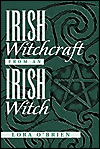
O'Brien is very proud to be a native of Ireland and she describes her homeland, history, and myths beautifully. The reader can tell she is proud of her heritage and homeland; however she manages to alienate the reader right at the beginning by stating “Genuine Irish family ancestry does not make you Irish” (page 27). She seems to disdain all people outside Ireland who claim to be Irish which comes through clearly in her writing. Sadly any Irish descendants reading this might be turned off by her claims.
O’Brien has the Irish tone and inflection in her writing and offers much information on how she, a resident of Ireland, practices her craft. Unfortunately she missed the mark in her book because she presented nothing more than the basic Wicca 101 material. She uses Irish traditions, myths, and deities to explore the typical topics in a beginner’s book – the sabbats, deity, rituals, tools, and so on. However, nothing she described was distinctly Irish and all of it could be found in any beginner witchcraft or pagan book. O'Brien does assert that traditionally the Irish would only celebrate the so-called major Sabbats which include Samhain, Imbolg, Bealtaine and Lughnasadh. In her opinion, the celebrating of all the sabbats was more for honoring ancestors than a true connection with nature. The strength of her beliefs comes through in an almost offensive tone.
O’Brien divides her book up into three sections; how it was, how it is, and how it will be, with the majority spent on describing how it was (more than half of the book). She incorporates myths, legends, fairies, and trials of a witch’s life in this section. Informative in her approach, she still manages to talk down to the reader. She uses Gaelic throughout the book and provides a pronunciation key but is a bit sarcastic about providing that help. Most readers can find many competent and informative books on Irish history and the aspects she discusses; again she does not offer anything new or illuminating in this section.
In the section “how it is” O’Brien combines land, gods, cycle, sabbats, and stages of a witch’s life. Here she (finally) includes some new material. For example, instead of the typical three phases of a life (maiden Mother Crone) she has eight. Mostly though, these stages are just subcategories of the three major stages of life. She spends some time and detail explaining that the Sidhe are a malevolent group of beings who are to be feared; in her opinion almost all interactions with any of these beings is a Very Bad Idea. When she describes her encounter with the Goddess Morrigan she confesses to leaving parts out – understandable if the encounter was intensely personal. Unfortunately the parts that were left out seem to have been the substance of the meeting, leaving the reader feeling mystified. Even worse, O’brien could be describing any goddess from any pantheon. Some private practices need to remain private but if the author does not adequately describe the experience the reader is unable to relate to the experience.
Although O'Brien purports her book to be from the Irish perspective rather than a Wicca 101 book, in the end she is a good story teller with an easy style to read. But she fell short on the Irish side of her practice. It would have been better titled as An Irish Witch’s First Book of Wicca.
~review by Eileen Troemel
Author: Lora O'Brien
New Page Books, 2005
